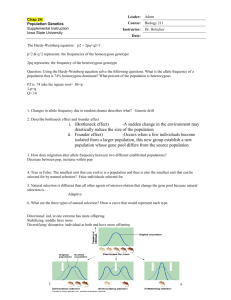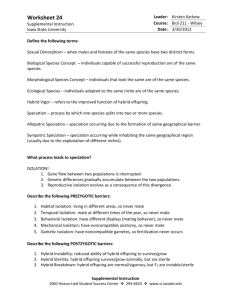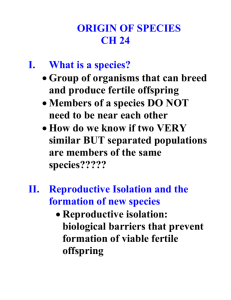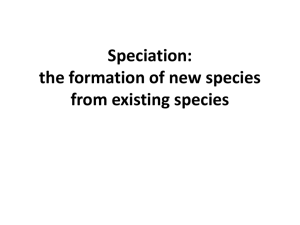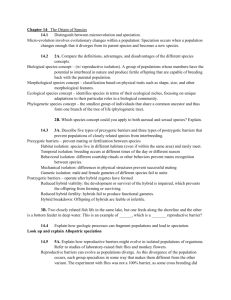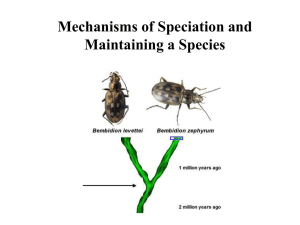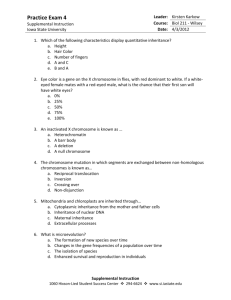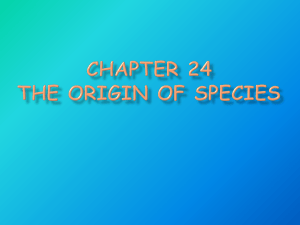Origin of Species Handout
advertisement
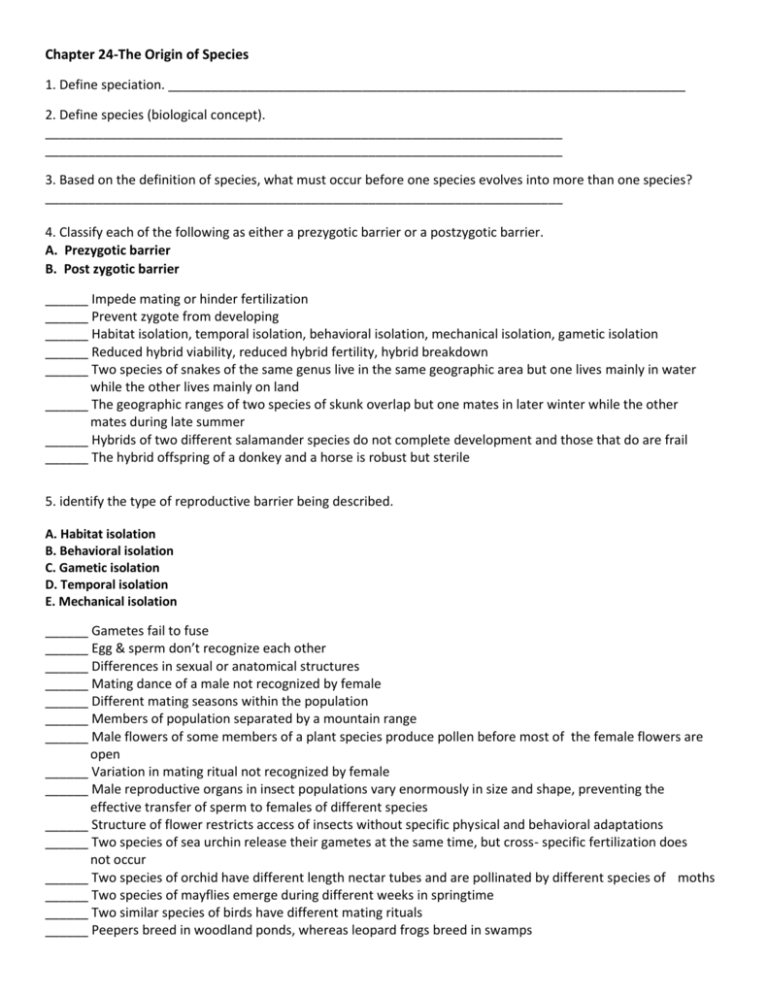
Chapter 24-The Origin of Species 1. Define speciation. ________________________________________________________________________ 2. Define species (biological concept). ________________________________________________________________________ ________________________________________________________________________ 3. Based on the definition of species, what must occur before one species evolves into more than one species? ________________________________________________________________________ 4. Classify each of the following as either a prezygotic barrier or a postzygotic barrier. A. Prezygotic barrier B. Post zygotic barrier ______ Impede mating or hinder fertilization ______ Prevent zygote from developing ______ Habitat isolation, temporal isolation, behavioral isolation, mechanical isolation, gametic isolation ______ Reduced hybrid viability, reduced hybrid fertility, hybrid breakdown ______ Two species of snakes of the same genus live in the same geographic area but one lives mainly in water while the other lives mainly on land ______ The geographic ranges of two species of skunk overlap but one mates in later winter while the other mates during late summer ______ Hybrids of two different salamander species do not complete development and those that do are frail ______ The hybrid offspring of a donkey and a horse is robust but sterile 5. identify the type of reproductive barrier being described. A. Habitat isolation B. Behavioral isolation C. Gametic isolation D. Temporal isolation E. Mechanical isolation ______ Gametes fail to fuse ______ Egg & sperm don’t recognize each other ______ Differences in sexual or anatomical structures ______ Mating dance of a male not recognized by female ______ Different mating seasons within the population ______ Members of population separated by a mountain range ______ Male flowers of some members of a plant species produce pollen before most of the female flowers are open ______ Variation in mating ritual not recognized by female ______ Male reproductive organs in insect populations vary enormously in size and shape, preventing the effective transfer of sperm to females of different species ______ Structure of flower restricts access of insects without specific physical and behavioral adaptations ______ Two species of sea urchin release their gametes at the same time, but cross- specific fertilization does not occur ______ Two species of orchid have different length nectar tubes and are pollinated by different species of moths ______ Two species of mayflies emerge during different weeks in springtime ______ Two similar species of birds have different mating rituals ______ Peepers breed in woodland ponds, whereas leopard frogs breed in swamps 6. Match the type of postzygotic barrier with the correct description. A. Reduced hybrid viability B. Reduced hybrid fertility C. Hybrid breakdown ______ Zygote fails to develop; zygote fails to reach sexual maturity ______ Hybrid fails to produce functional gametes ______ Offspring not viable or infertile; offspring of hybrid have reduced viability or fertility ______ Two species of frogs are mated in the lab and produce viable, but sterile, offspring ______ Two species of salamanders will mate in the lab and produce viable, fertile offspring, but offspring of these hybrids are sterile ______ When two species of mice are bred in the lab, embryos usually abort 7. Two bird species in a forest are not known to interbreed. One species feeds and mates in the treetops and the other on the ground. But in captivity, the two species can interbreed and produce viable fertile offspring. What type of reproductive barrier most likely keeps these species separate? Explain. ___________________________________________________________________________________________ ____________________________________________________________________________________________ 8. How is allopatric speciation different from sympatric speciation? ______________________________________________________________________ ________________________________________________________________________ ________________________________________________________________________ 9. Explain how each of the following can result in sympatric speciation. Polyploidy: ______________________________________________________________ _______________________________________________________________________ _______________________________________________________________________ Habitat differentiation: ____________________________________________________ _______________________________________________________________________ _______________________________________________________________________ Sexual selection: _________________________________________________________ _______________________________________________________________________ _______________________________________________________________________ 10. Indicate if each of the following statements is true of Gradualism or Punctuated Equilibrium. ______ Gradual divergence of a species from the ancestral form ______ Most change occurred when species branched from ancestral form ______ Long periods of stasis punctuated by episodes of speciation ______ Darwinism ______ Evolution occurred in spurts of rapid change ______ Big changes occur from the accumulation of many small ones

